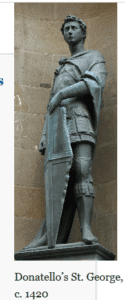![sangiorgiodidonatello]()
From the
WSJ, a somewhat overstated headline:
The Wealthy in Florence Today Are the Same Families as 600 Years AgoResearchers compared data on Florentine taxpayers in 1427 against tax data in 2011 and found about 900 surnames still present in Florence
By JOSH ZUMBRUN
May 19, 2016 8:53 am ET
New research from a pair of Italian economists documents an extraordinary fact: The wealthiest families in Florence today are descended from the wealthiest families of Florence nearly 600 years ago.
The two economists — Guglielmo Barone and Sauro Mocetti of the Bank of Italy — compared data on Florentine taxpayers in 1427 against tax data in 2011.
Keep in mind that Florence 1427 was the most advanced place in the Western world. Its residents at the time included the three friends Donatello the sculptor,
Brunelleschi the architect, and Masaccio the painter. It’s fairly likely that as part of designing the famous dome of the cathedral of Florence, the first dome built in the West since Roman times, Brunelleschi worked out the science of perspective and showed his friends how to apply it to bas-relief and painting, respectively. This was the mega-discovery that, more than anything else, set off the artistic Renaissance. (A generation later in Germany came the giga-invention, printing.)
![]() Because Italian surnames are highly regional and distinctive, they could compare the income of families with a certain surname today, to those with the same surname in 1427. They found that the occupations, income and wealth of those distant ancestors with the same surname can help predict the occupation, income and wealth of their descendants today.
Because Italian surnames are highly regional and distinctive, they could compare the income of families with a certain surname today, to those with the same surname in 1427. They found that the occupations, income and wealth of those distant ancestors with the same surname can help predict the occupation, income and wealth of their descendants today.As they wrote for the economics commentary website VoxEU, “The top earners among the current taxpayers were found to have already been at the top of the socioeconomic ladder six centuries ago.”
Their research was made possible by a fiscal crisis. In 1427, Florence was near bankrupt from an ongoing war with Milan and so the Priors of the Republic conducted a tax census of about 10,000 citizens. They took stock of the name and surname of the head of household, their occupation and their wealth.
… They find strong evidence that socioeconomic status is incredibly persistent. The wealthiest surnames in Florence today belong to families that, in 1429, were members of the shoemakers’ guild — at the 97th percentile of income. Descendants of members of the silk guild and descendants of attorneys — both at the 93rd percentile in 1427 — are among the wealthiest families today.
Some of the wealthiest families in Florence today had ancestors who were prosperous shoemakers in the 1400s. Here, Salvatore Ferragamo–who died in 1960 and thus was not in the scope of this report–shows off his Florentine workshop where he made shoes for celebrities.
Florentine cobblers might still be the best in the world. When actor Daniel Day-Lewis felt burned out from movies, he disappeared for a couple of years from show biz to apprentice under a master cobbler in Florence. The break appears to have done him good: he returned to win his second and unprecedented third Best Actor Oscars.
The effect isn’t huge: the two economists write:
More rigorous empirical analysis confirms this evidence. When regressing the pseudo-descendant’s earnings on pseudo-ancestor’s earnings, the results are surprising: the long-run earnings elasticity is positive, statistically significant, and equals about 0.04. Stated differently, being the descendants of the Bernardi family (at the 90th percentile of earnings distribution in 1427) instead of the Grasso family (10th percentile of the same distribution) would entail a 5% increase in earnings among current taxpayers (after adjusting for age and gender). Intergenerational real wealth elasticity is significant too and the magnitude of its implied effect is even larger: the 10th-90th exercise entails more than a 10% difference today. Looking for non-linearities, we find, in particular, some evidence of the existence of a glass floor that protects the descendants of the upper class from falling down the economic ladder.
But 589 years is a long time for anything to persist.
One persistent worry about surname analysis is whether there’s a history of name-changing up the social ladder. Perhaps, say, it’s not unknown for the master cobbler’s best apprentice to marry the boss’s daughter and take his father in law’s surname?
[Comment at Unz.com]




 From the WSJ, a somewhat overstated headline:
From the WSJ, a somewhat overstated headline:
 Because Italian surnames are highly regional and distinctive, they could compare the income of families with a certain surname today, to those with the same surname in 1427. They found that the occupations, income and wealth of those distant ancestors with the same surname can help predict the occupation, income and wealth of their descendants today.
Because Italian surnames are highly regional and distinctive, they could compare the income of families with a certain surname today, to those with the same surname in 1427. They found that the occupations, income and wealth of those distant ancestors with the same surname can help predict the occupation, income and wealth of their descendants today.








